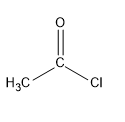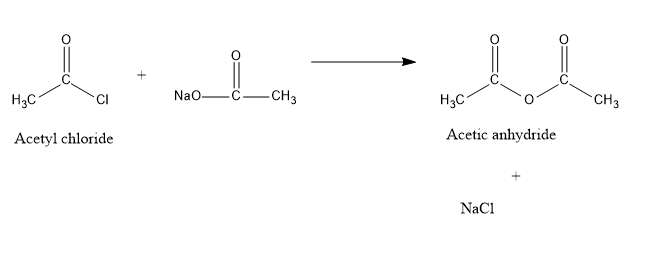
Sodium acetate reacts with acetyl chloride to form:
A. Acetone
B. Acetic anhydride
C. Sodium formate
D. Acetic acid
Answer
222k+ views
Hint: Acetyl chloride belongs to the class of acyl chloride that we get from acetic acid. Acetyl chloride also belongs to the group of acid halides. It has no colour. It is a liquid of volatile nature. And it is a corrosive substance. Acetyl chloride also belongs to the group of acid halides. It has no colour. It is a liquid of volatile nature. And it is a corrosive substance.
Complete step by step answer:
Let's first draw the structure of acetyl chloride.

Image: Acetyl chloride
Sodium acetate is an organic compound that is a derivative of carboxylic acid. In sodium acetate, the H atom of OH group of a carboxylic group is replaced by a sodium atom. The formula of sodium acetate is,\[{\rm{C}}{{\rm{H}}_{\rm{3}}}{\rm{COONa}}\] .
Now, we have to understand the reaction of sodium acetate and acetyl chloride. When sodium acetate undergoes a reaction with acetyl chloride, the formation of acetic anhydride takes place. In this reaction, a molecule of Sodium chloride (NaCl) is extracted. The chemical reaction is as follows:

Image: Formation of acetic anhydride due to the reaction of sodium acetate and acetyl chloride
Hence, the product formed due to the reaction of acetyl chloride and sodium acetate is acetic anhydride.
Note: Acetic anhydride is a liquid of no colour possessing a sharp odour. It is useful in the manufacture of drugs, dyes, perfumes etc. It is extremely corrosive in nature. It becomes dangerous when it comes in contact. So, it is banned by the authorities.
Complete step by step answer:
Let's first draw the structure of acetyl chloride.

Image: Acetyl chloride
Sodium acetate is an organic compound that is a derivative of carboxylic acid. In sodium acetate, the H atom of OH group of a carboxylic group is replaced by a sodium atom. The formula of sodium acetate is,\[{\rm{C}}{{\rm{H}}_{\rm{3}}}{\rm{COONa}}\] .
Now, we have to understand the reaction of sodium acetate and acetyl chloride. When sodium acetate undergoes a reaction with acetyl chloride, the formation of acetic anhydride takes place. In this reaction, a molecule of Sodium chloride (NaCl) is extracted. The chemical reaction is as follows:

Image: Formation of acetic anhydride due to the reaction of sodium acetate and acetyl chloride
Hence, the product formed due to the reaction of acetyl chloride and sodium acetate is acetic anhydride.
Note: Acetic anhydride is a liquid of no colour possessing a sharp odour. It is useful in the manufacture of drugs, dyes, perfumes etc. It is extremely corrosive in nature. It becomes dangerous when it comes in contact. So, it is banned by the authorities.
Recently Updated Pages
Types of Solutions in Chemistry: Explained Simply

States of Matter Chapter For JEE Main Chemistry

Difference Between Alcohol and Phenol: Structure, Tests & Uses

Conduction Explained: Definition, Examples & Science for Students

Balancing of Redox Reactions - Important Concepts and Tips for JEE

Atomic Size - Important Concepts and Tips for JEE

Trending doubts
JEE Main 2026: Application Form Open, Exam Dates, Syllabus, Eligibility & Question Papers

Derivation of Equation of Trajectory Explained for Students

Hybridisation in Chemistry – Concept, Types & Applications

Understanding the Angle of Deviation in a Prism

How to Convert a Galvanometer into an Ammeter or Voltmeter

Degree of Dissociation: Meaning, Formula, Calculation & Uses

Other Pages
Solutions Class 12 Chemistry Chapter 1 CBSE Notes - 2025-26

NCERT Solutions For Class 12 Chemistry Chapter 1 Solutions - 2025-26

The D and F Block Elements Class 12 Chemistry Chapter 4 CBSE Notes - 2025-26

NCERT Solutions for Class 12 Chemistry Chapter Chapter 7 Alcohol Phenol and Ether

NCERT Solutions ForClass 12 Chemistry Chapter Chapter 8 Aldehydes Ketones And Carboxylic Acids

JEE Advanced Marks vs Ranks 2025: Understanding Category-wise Qualifying Marks and Previous Year Cut-offs




